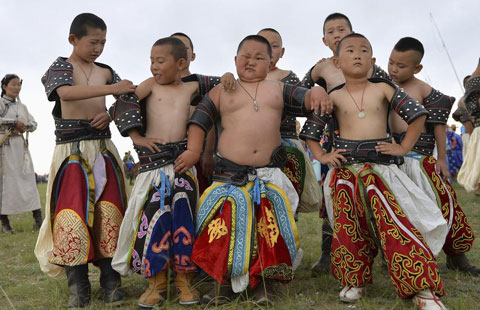Relaxation of policy needs to be gradual
Updated: 2014-08-15 10:20
By Zhai Zhenwu(China Daily Europe)
|
|||||||||||

Allowing the population to grow rapidly in a short time would put huge burdens on social services
China has succeeded in curbing its excessively rapid population growth and reducing its fertility rate through its rigid family planning policy over the past three decades. The population growth rate has dropped from 2.5 percent in 1960 to 0.5 percent nowadays, and the yearly average number of newborns has dropped from 27 million in the 1960s to 16 million now. Based on the current growth trend, China's population will step into a zero growth era in the 2030s. The changing population situation has drawn wide public attention to the adjustment of the family planning policy.
Under the influence of the family planning policy during the past three decades, China has accumulated 180 million to 190 million single children in its families, and the number of only children whose mothers are under the age of 50 is about 150 million. This means there are about 150 million couples where either the husband or the wife is the only child. By opening up the family planning policy to allow these families to have a second child, all these 150 million couples are immediately qualified to have a second child. According to many national surveys, about 60 percent of couples say they would like a second child, which suggests about 90 million babies will be born in the near future.
This accumulation effect will be gradually released in several years after the adjustment of the policy. Without restriction, Chinese women's average birth spacing is three to four years. It is estimated that women who have already given birth to a child will have another within about four years. If we suppose for the sake of argument that these women's birth timing will be uniformly distributed at four years, it can be estimated there will be an extra 22.5 million births every year in the following four years due to the release of accumulated childbirth power. There are now about 16 million newborn every year in China. And there will be about 40 million newborn every year in the following four years now the policy has been relaxed.
However, this argument is unrealistic because the women who want to have a second child will not give birth to babies according to this theoretical timeline. Statistics show that the release of accumulated fertility power will peak in the third and fourth year. Under such circumstances, in the peak year there will be more than 40 million newborn babies in China, while the country's highest yearly newborn population after the founding of New China has been 29 million.
There are some who argue that the family planning policy should be relaxed to allow all couples a second child.
Immediately easing the family planning policy to allow all families to have a second child would alleviate the aging problem and labor shortage. But the rapid population growth in the short term would result in a more unbalanced population structure, and it would finally break China's population control target of 1.5 billion. Rapid population growth over a short period would place a heavy, and possibly unbearable, burden on hospitals, kindergartens and schools. China's basic national demographic conditions have not drastically changed much: China still has a huge population and a shortage of per capital resources. If the overall population exceeds 1.5 billion, it will have negative effects on resources, the environment and food supply, which goes against sustainable development.
China has adopted an adjusted family planning policy to allow couples where either the husband or the wife is the only child to have a second child, which will release some of the accumulated fertility power. This policy will add 2 to 3 million new births every year, which public services will be able to cope with.
If we can gradually adjust and improve the family planning policy, there will be less accumulated fertility power and less yearly population growth, and China's strategic population target of 1.5 billion will not be exceeded.
A country's population is the main body and base of its economy, and demographic change will have a long-term, profound and overall influence on society. Currently the demographic policy is still the main factor that determines population changes.
Therefore, the adjustment of demographic policy should consider both the present and the future; and take into account economic, social and resource factors. Current conditions mean the time is not yet ripe for immediately and completely relaxing the family planning policy. It is better to gradually release part of the accumulated fertility power and further adjust family planning policy after a few years, which will lead to a more balanced population that can support economic and social development.
The author is director of the School of Sociology and Population Studies at Renmin University of China. The views do not necessarily reflect those of China Daily.
(China Daily European Weekly 08/15/2014 page11)
Today's Top News
British Chinese call for memorial to WWI workers
Pollution control set as priority for APEC meeting
Swimmer nabs silver at Gay Games in the US
China exports to Russia to surge
Chinese economic crime suspects repatriated
Ukraine deaths double in 2 weeks
Sensitive times in the making
Chinese film fans mourn for star
Hot Topics
Lunar probe , China growth forecasts, Emission rules get tougher, China seen through 'colored lens', International board,
Editor's Picks

|

|

|

|

|

|





